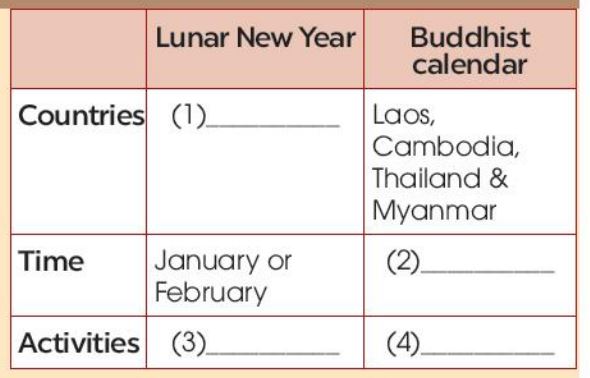Bài học cung cấp cho các em những cách diễn đạt khi đưa ra lời khen và đáp lại lời khen đó. HOC247 mời các em tìm hiểu bài học Unit 4 - Communication and Culture / CLIL nằm trong bộ sách Tiếng Anh 11 Kết nối tri thức. Bên cạnh đó, các em còn được đọc hiểu thêm vốn từ vựng phong phú. Chúc các em học tốt!
Tóm tắt bài
1.1. Unit 4 lớp 11 Everyday English Task 1
Giving and responding to compliments
(Đưa ra lời khen và đáp lại lời khen)
Listen and complete the conversation with the expressions in the box. Then practise it in pairs.
(Nghe và hoàn thành cuộc hội thoại với các biểu thức trong hộp. Sau đó thực hành nó theo cặp.)
Guide to answer
1 – C
2 – A
3 – D
4 – B
Linda: I was at the workshop at the ASEAN Youth Volunteer Conference. (1) C. You gave the best presentation!
Hoa: (2) A. I'm glad you like it, Linda. I worked really hard to prepare for it.
Linda: It's was also well organised. And I noticed that your English has improved a lot. (3) D. It’s excellent.
Hoa: Thank you. (4) B. I appreciate the compliment.
Tạm dịch
Linda: Tôi đã tham gia hội thảo tại Hội nghị Tình nguyện viên Thanh niên ASEAN. Bạn đã trình bày tốt nhất!
Hoa: Tôi rất vui vì bạn thích nó, Linda. Tôi đã làm việc rất chăm chỉ để chuẩn bị cho nó.
Linda: Nó cũng được tổ chức tốt. Và tôi nhận thấy rằng tiếng Anh của bạn đã được cải thiện rất nhiều. Nó là tuyệt vời.
Hoa: Cảm ơn bạn. Tôi đánh giá cao lời khen.
1.2. Unit 4 lớp 11 Everyday English Task 2
Work in pairs. Use the model in 1 to make similar conversations for these situations. One of you is Student A, the other is Student B. Use the expressions below to help you.
(Làm việc theo cặp. Sử dụng mô hình trong phần 1 để tạo các hội thoại tương tự cho các tình huống này. Một trong số các bạn là Học sinh A, người kia là Học sinh B. Sử dụng các biểu thức dưới đây để giúp bạn)
1. Student A has completed an excellent report on ASEAN. Student B gives compliments and Student A responds.
(Học sinh A đã hoàn thành xuất sắc bài báo cáo về ASEAN. Học sinh B khen ngợi và học sinh A hưởng ứng.)
2. Student B has organised a workshop on skills for future leaders in ASEAN. Student A gives compliments and Student B responds.
(Học sinh B đã tổ chức hội thảo về kỹ năng cho các nhà lãnh đạo tương lai ở ASEAN. Học sinh A khen ngợi và học sinh B đáp lại.)
Guide to answer
1.
Student A: I just submitted my report on ASEAN. I'm hoping to get a good grade on it.
Student B: Wow, this report is amazing! You did an excellent job on the research and the writing is very clear.
Student A: Thank you so much for the compliment. I put a lot of effort into it, so it's great to hear that it's appreciated.
2.
Student B: I recently organized a workshop on skills for future leaders in ASEAN.
Student A: That sounds really interesting. How did it go?
Student B: It went really well! I received a lot of positive feedback from the participants.
Student A: That's great to hear! You did an excellent job with the organization and the content was very informative.
Student B: Thank you, that means a lot coming from you. I put a lot of time and effort into making sure it was a success.
Tạm dịch
1.
Student A: Tôi vừa nộp báo cáo về ASEAN. Tôi hy vọng sẽ đạt được điểm cao về nó.
Student B: Ồ, báo cáo này thật tuyệt vời! Bạn đã làm một công việc xuất sắc trong nghiên cứu và văn bản rất rõ ràng.
Student A: Cảm ơn bạn rất nhiều vì lời khen. Tôi đã nỗ lực rất nhiều vào nó, vì vậy thật tuyệt khi biết rằng nó được đánh giá cao.
2.
Student B: Gần đây tôi đã tổ chức một hội thảo về kỹ năng cho các nhà lãnh đạo tương lai ở ASEAN.
Student A: Điều đó nghe thật thú vị. Nó đã diễn ra như thế nào?
Student B: Nó diễn ra rất tốt! Tôi đã nhận được rất nhiều phản hồi tích cực từ những người tham gia.
Student A: Thật tuyệt khi được nghe! Bạn đã làm một công việc tuyệt vời với tổ chức và nội dung rất nhiều thông tin.
Student B: Cảm ơn bạn, điều đó có nghĩa là rất nhiều từ bạn. Tôi đã dành rất nhiều thời gian và công sức để đảm bảo rằng nó thành công.
1.3. Unit 4 lớp 11 Culture Task 1
Read the text and complete the table below.
(Đọc văn bản và hoàn thành bảng dưới đây.)
New Year Festivals in ASEAN
In ASEAN, besides welcoming the New Year on January 1, there are several cultures that. celebrate New Year's Day later in the year. For example, Viet Nam, Singapore, Indonesia and parts of Malaysia follow the lunar calendar so their New Year festivities often take place in January or February. Lunar New Year is a time for them to honour ancestors, get together with family and friends, have a big family meal, and wish one another prosperity for the year to come. The streets and houses are decorated, and fireworks are lit to scare away bad luck. There are also parades, street parties, and art performances in the new year celebrations.
People in Laos, Cambodia, Thailand, and Myanmar celebrate the arrival of the New Year according to the Buddhist calendar. Their New Year's celebrations are in April. People in these countries follow traditions such as offering rice to Buddhist monks to show their respect and receiving wishes for good luck and health from them. They decorate their homes, cook traditional dishes, and splash each other with water. There are also art performances, folk games, and dancing.
In these cultures, it is believed that water will wash away bad luck and ill health from the old year and allow people to start the new year fresh.
Guide to answer
|
|
Lunar New Year (Tết nguyên đán) |
Buddhist calendar (Phật lịch) |
|
Countries (Quốc gia)
|
(1) Viet Nam, Singapore, Indonesia, and parts of Malaysia (Việt Nam, Xin-ga-po, In-đô-nê-xi-a, và các nơi của Ma-lai-xi-a) |
Laos, Cambodia, Thailand & Myanmar (Lào, Cam-pu-chia, Thái Lan & Mi-an-ma) |
|
Time (Thời gian)
|
January or February (tháng 1 hoặc tháng 2) |
(2) April (tháng 4) |
|
Activities (Các hoạt động)
|
(3) Honour ancestors, family gathering, big family meal, wishing for prosperity, decorations, fireworks, parades, street parties, and art performances. (Thờ cúng tổ tiên, họp mặt gia đình, bữa cơm đại gia đình, cầu chúc thịnh vượng, trang trí, bắn pháo hoa, diễu hành, tiệc đường phố và biểu diễn nghệ thuật.) |
(4) Offering rice to Buddhist monks, receiving wishes for good luck and health, home decorations, traditional dishes, water splashing, art performances, folk games, and dancing. (Dâng cơm cúng các nhà sư, cầu chúc sức khỏe, may mắn, trang trí nhà cửa, các món ăn truyền thống, té nước, văn nghệ, trò chơi dân gian, múa hát.) |
Tạm dịch
Lễ hội Tết Nguyên Đán ở các nước Đông Nam Á
Ở ASEAN, bên cạnh việc đón năm mới vào ngày 1 tháng Giêng, có một số nền văn hóa cũng vậy. mừng ngày đầu năm mới vào cuối năm. Ví dụ, Việt Nam, Singapore, Indonesia và một phần của Malaysia theo âm lịch nên lễ hội năm mới của họ thường diễn ra vào tháng Giêng hoặc tháng Hai. Tết Nguyên đán là thời điểm để họ tỏ lòng thành kính với tổ tiên, sum họp với gia đình và bạn bè, dùng bữa cơm gia đình thịnh soạn và chúc nhau làm ăn phát đạt trong năm tới. Đường phố và nhà cửa được trang trí, và pháo hoa được đốt để xua đuổi những điều xui xẻo. Ngoài ra còn có các cuộc diễu hành, tiệc đường phố và biểu diễn nghệ thuật trong lễ kỷ niệm năm mới.
Người dân Lào, Campuchia, Thái Lan và Myanmar chào mừng năm mới theo Phật lịch. Lễ kỷ niệm năm mới của họ là vào tháng Tư. Người dân ở những quốc gia này tuân theo các truyền thống như dâng cơm cho các nhà sư Phật giáo để bày tỏ lòng kính trọng và nhận được những lời chúc may mắn và sức khỏe từ họ. Họ trang trí nhà cửa, nấu các món ăn truyền thống và té nước vào nhau. Ngoài ra còn có các tiết mục văn nghệ, trò chơi dân gian, dân vũ.
Ở những nền văn hóa này, người ta tin rằng nước sẽ gột rửa những điều xui xẻo và bệnh tật của năm cũ và cho phép mọi người bắt đầu một năm mới tươi mới.
1.4. Unit 4 lớp 11 Culture Task 2
Work in pairs. Discuss the similarities and differences between the New Year Festivals in Viet Nam and other ASEAN countries.
(Thảo luận về những điểm tương đồng và khác biệt giữa Tết Nguyên Đán ở Việt Nam và các nước ASEAN khác.)
Guide to answer
The New Year Festivals in Viet Nam and other ASEAN countries have some similarities and differences, which are outlined below.
|
Similarities |
Differences |
|
|
In summary, while there are some similarities between the New Year Festivals in Viet Nam and other ASEAN countries, the differences in timing, customs, and traditional dishes reflect the unique cultural identities of each country.
Tạm dịch
Tết Nguyên Đán ở Việt Nam và các nước ASEAN khác có một số điểm tương đồng và khác biệt, được trình bày dưới đây.
Điểm tương đồng:
- Cả Việt Nam và các nước ASEAN khác đều tổ chức Lễ hội Năm mới để tôn vinh tổ tiên và cầu mong những điều may mắn, thịnh vượng và sức khỏe cho một năm tới.
- Lễ hội năm mới ở cả Việt Nam và các nước ASEAN khác liên quan đến việc họp mặt gia đình, bữa ăn gia đình lớn, trang trí và biểu diễn nghệ thuật.
- Pháo hoa được đốt để xua đuổi những điều xui xẻo trong lễ đón Tết Nguyên đán ở Việt Nam, Singapore, Indonesia và một số vùng của Malaysia, trong khi nước được sử dụng để gột rửa những điều xui xẻo trong lễ đón năm mới ở Lào, Campuchia, Thái Lan và Myanmar .
Sự khác biệt:
- Thời gian diễn ra Tết Dương lịch ở Việt Nam và các nước ASEAN khác nhau. Việt Nam, Singapore, Indonesia và một phần của Malaysia tổ chức Lễ hội năm mới vào tháng Giêng hoặc tháng Hai theo âm lịch, trong khi Lào, Campuchia, Thái Lan và Myanmar tổ chức lễ hội của họ vào tháng Tư theo Phật lịch.
- Cách bày tỏ lòng kính trọng với tổ tiên và nhận những lời chúc may mắn, sức khỏe là khác nhau giữa Việt Nam và các nước ASEAN khác. Ở Việt Nam, người dân thắp hương và cúng đồ ăn thức uống cho tổ tiên tại bàn thờ gia tiên hoặc chùa chiền, trong khi ở Lào, Campuchia, Thái Lan và Myanmar, người dân cúng cơm cho các nhà sư và nhận lời chúc từ họ.
- Các lễ hội năm mới ở Việt Nam và các nước ASEAN khác có các món ăn truyền thống khác nhau. Ví dụ, ở Việt Nam, mọi người thường ăn bánh nếp và thịt gà luộc, trong khi ở Lào, Campuchia, Thái Lan và Myanmar, mọi người ăn nhiều món ăn truyền thống khác nhau như gỏi đu đủ, canh cá hoặc xôi.
Tóm lại, trong khi có một số điểm tương đồng giữa Lễ hội Năm mới ở Việt Nam và các nước ASEAN khác, thì sự khác biệt về thời gian, phong tục và các món ăn truyền thống phản ánh bản sắc văn hóa độc đáo của mỗi quốc gia.
Bài tập minh họa
Fill in the blank with the suitable words
(Điền vào chỗ trống với từ thích hợp)
|
supported |
movements |
population |
important |
mass media |
working-class |
|
A literate 1__________is a necessity for any nation wishing to take advantage of modern technological growth. For instance, research has shown a direct relationship between literacy among women and improved health' and child care in the family. The United Nations Educational, Scientific, and Cultural Organization (UNESCO) has long 2__________ the concept that education must be considered an ongoing process. Adult education has long been 3__________ in Europe, where formal programs began in the 18th century. In Britain, concern for the education of poor and 4__________ people resulted in the growth of adult education programs, such as the evening school and the, Mechanic's Institute, to expand education opportunities for all people: ,After the Russian Revolution, the Russian government virtually eliminated illiteracy through the establishment of various institutions and extension classes for adults. In other areas of the world, adult education 5__________ are of a more recent origin. In 1960, Egypt established a 'schools for the people' system designed to educate the adult population. In the 1970s, countries in Africa, Asia, and Latin America began to increase opportunities for adult education. Innovative programs involving the 6__________ are being used in many countries. Tanzania, for example, has used mass education techniques and the radio to organize national education programs in health, nutrition, and citizenship. In the 1980s, international educational exchange programs grew in popularity in the United States and many other countries. |
Key (Đáp án)
1. population
2. supported
3. important
4. working-class
5. movements
6. mass media
Luyện tập
3.1. Kết luận
Qua bài học này các em cần ghi nhớ các từ vựng sau:
- festivity: lễ hội; sự kiên vui vẻ, hoan hỉ
- take place: diễn ra
- honour ancestor: thờ cúng tổ tiên
- get together = gather: tụ họp
- prosperity: sự phát đạt
- be lit to: được bật lên
- scare away: bật lên
- parade: diễu hành
- Buddhist monk: tu sĩ Phật giáo
- wash away: rửa sạch
3.2. Bài tập trắc nghiệm Unit 4 - Communication and Culture / CLIL
Như vậy là các em đã xem qua bài giảng Unit 4 - Communication and Culture / CLIL chương trình Tiếng Anh lớp 11 Kết nối tri thức. Để củng cố kiến thức bài học mời các em tham gia bài tập trắc nghiệm Trắc nghiệm Unit 4 lớp 11 Kết nối tri thức Communication and Culture / CLIL - Truyền thông và Văn hóa / CLIL.
-
- A. She offered us some apples in return for our help.
- B. She let us have as many apples as we wanted.
- C. She wanted our help to pick the apples and put them in a basket.
- D. She wanted us to do all the work ourselves.
-
- A. The book was brought back last week.
- B. The book should have been returned a week ago.
- C. The book has already been borrowed for a week.
- D. The book can't be kept longer than a week.
-
- A. If Mike is able to finish his homework
- B. Would Mike be able to finish his homework
- C. If Mike could finish his homework
- D. Had Mike been able to finish his homework
Câu 4-10: Mời các em đăng nhập xem tiếp nội dung và thi thử Online để củng cố kiến thức về bài học này nhé!
-- Mod Tiếng Anh 11 HỌC247













